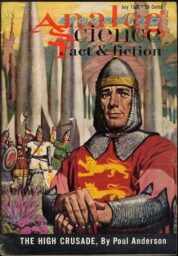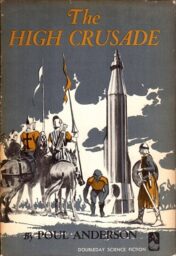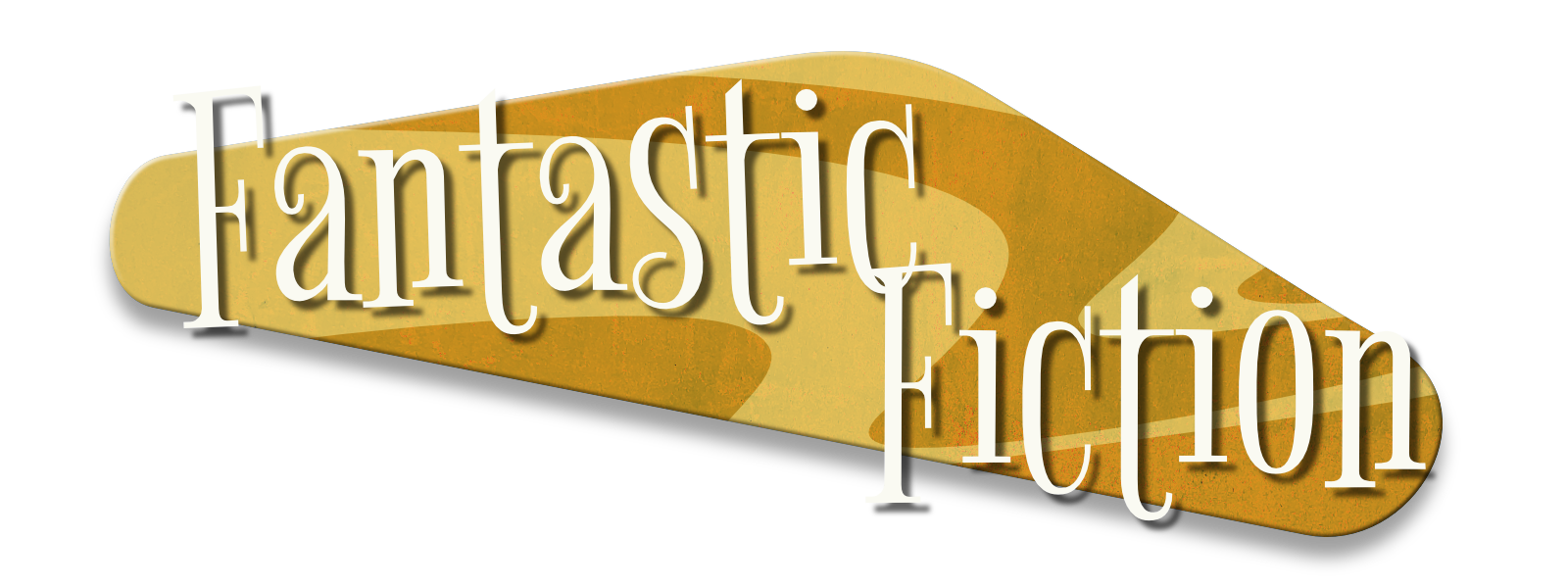Science fiction often begins with a question of “what if”? And in 1960, Poul Anderson asked just such a question: What if aliens attempting to invade the Earth encountered a troop of medieval knights? And what if the knights won the ensuing struggle? This is the premise of The High Crusade, one of the most offbeat and entertaining science fiction novels of the early 1960s.
 Serialised in the newly rechristened Analog between July and September 1960, The High Crusade opens in England in 1345 AD, where Sir Roger de Tourneville is recruiting soldiers to fight the French in the Hundred Years’ War. His efforts are rudely interrupted by the arrival of an alien scoutship from the Wersgorix Empire. The English soldiers mistake the blue-skinned invaders for demons and when it turns out that aliens are not impervious to English longbows, they storm the spaceship and slaughter the crew, capturing only the alien Branithar alive.
Serialised in the newly rechristened Analog between July and September 1960, The High Crusade opens in England in 1345 AD, where Sir Roger de Tourneville is recruiting soldiers to fight the French in the Hundred Years’ War. His efforts are rudely interrupted by the arrival of an alien scoutship from the Wersgorix Empire. The English soldiers mistake the blue-skinned invaders for demons and when it turns out that aliens are not impervious to English longbows, they storm the spaceship and slaughter the crew, capturing only the alien Branithar alive.
Suddenly finding himself in possession of a spaceship and alien weaponry, Sir Roger decides to use this unexpected gift from the stars to conquer France and kick the Saracens out of the Holy Land. So Sir Roger, his family, his troops and the entire village, including the friars of the local abbey, board the spaceship, now christened the Crusader, and force Branithar to take them to France. Branithar, however, tricks his captors and sends the Crusader into deep space instead, hurtling towards the nearest Wersgorix outpost.
But such a minor inconvenience will not keep the righteous spirit of the English soldiers down. And so Sir Roger and his forces set out to conquer the Wersgorix base – since it turns out that force fields do little good against arrows and the aliens are not skilled at close quarters combat – and eventually the entire planet. However, Sir Roger isn’t done yet and proceeds to conquer the Wersgorix Empire for the glory of God and King Edward III…
Nowadays, Poul Anderson is remembered as much for his pioneering fantasy novels The Broken Sword and Three Hearts and Three Lions as for his science fiction, but in 1960 he was considered mainly a science fiction writer and his fantasy works were viewed as odd passion projects. The High Crusade allowed Anderson to combine his interest in planet-spanning space opera and medieval adventure into a remarkably coherent whole.
 Even more than 60 years after it was first published, The High Crusade remains an incredibly entertaining romp. Poul Anderson isn’t normally considered a funny writer, but The High Crusade is very funny in places, whether it’s the story’s narrator, the exasperated monk Brother Parvus trying to teach Latin to the alien Branithar and trying to figure out if he has a soul (a concept Branithar does not understand), or the English soldiers burning down “a house, a pig, and serf” while experimenting with the aliens’ rayguns. Even the epilogue offers a chuckle, where the feudal space empire established by Sir Roger finally makes contact with an Earth spaceship a millennium later and the local baron asks the Earth captain if they finally managed to liberate the Holy Land, whereupon the Israeli captain replies “yes.”
Even more than 60 years after it was first published, The High Crusade remains an incredibly entertaining romp. Poul Anderson isn’t normally considered a funny writer, but The High Crusade is very funny in places, whether it’s the story’s narrator, the exasperated monk Brother Parvus trying to teach Latin to the alien Branithar and trying to figure out if he has a soul (a concept Branithar does not understand), or the English soldiers burning down “a house, a pig, and serf” while experimenting with the aliens’ rayguns. Even the epilogue offers a chuckle, where the feudal space empire established by Sir Roger finally makes contact with an Earth spaceship a millennium later and the local baron asks the Earth captain if they finally managed to liberate the Holy Land, whereupon the Israeli captain replies “yes.”
The High Crusade was a Hugo finalist at Seacon in Seattle in 1961, losing out to A Canticle for Leibowitz by Walter M. Miller. And how fascinating is it that even though science fiction is normally a very secular genre, in 1961 there were not one but two novels told from the POV of Catholic friars on the Hugo ballot? The High Crusade was filmed in 1994, though the movie, which played up the comedic aspects at the expense of the more serious elements, was not very good.
Have you read The High Crusade by Poul Anderson? Bring your thoughts and memories to Seattle. Or maybe impress us with your High Crusade-inspired cosplay. Let’s continue the discussion in Seattle.
Cora Buhlert is a writer and translator from Bremen in North Germany. She’s a contributor to Galactic Journey and the winner of the 2022 Hugo Award for best fan writer. You can also find her at her website.

